
The Channel Islands are an archipelago in the English Channel, off the French coast of Normandy. They are divided into two Crown Dependencies: the Bailiwick of Jersey, which is the largest of the islands; and the Bailiwick of Guernsey, consisting of Guernsey, Alderney, Sark, Herm and some smaller islands. Historically, they are the remnants of the Duchy of Normandy. Although they are not part of the United Kingdom, the UK is responsible for the defence and international relations of the islands as it is for the other Crown Dependency, the Isle of Man, and the British Overseas Territories. The Crown Dependencies are neither members of the Commonwealth of Nations, nor part of the European Union. They have a total population of about 171,916, and the bailiwicks' capitals, Saint Helier and Saint Peter Port, have populations of 33,500 and 18,207 respectively.
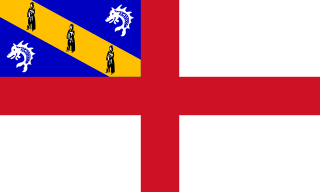
Herm is one of the Channel Islands and part of the Parish of St Peter Port in the Bailiwick of Guernsey. It is located in the English Channel, north-west of France and south of England. It is 2,183 m (7,162 ft) long and under 873 metres (2,864 ft) wide; oriented north–south, with several stretches of sand along its northern coast. The much larger island of Guernsey lies to the west, Jersey lies to the south-east, and the smaller island of Jethou is just off the south-west coast.
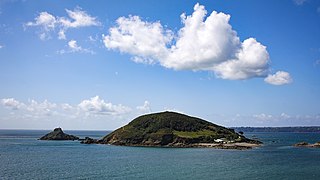
Jethou is a small island that is part of the Bailiwick of Guernsey in the Channel Islands. It is privately leased from the Crown, and not open to the public. Resembling the top of a wooded knoll, it is immediately south of Herm and covers approximately 44 acres (18 ha).
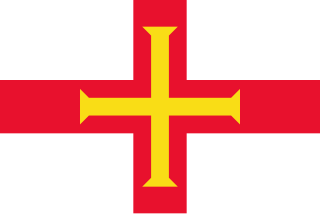
The flag of Guernsey was adopted in 1985 and consists of the red Saint George's Cross with an additional gold Norman cross within it. The creation was prompted by confusion at international sporting events over competitors from Guernsey and England using the same flag. It was designed by the Guernsey Flag Investigation Committee led by Deputy Bailiff Sir Graham Dorey. The flag was first unveiled on the island on 15 February 1985. The gold cross represents William the Bastard, Duke of Normandy. William purportedly was given such a cross by Pope Alexander II and flew it on his standard in the Battle of Hastings. Since 2000, a red ensign with the cross in the fly has been used as the government's civil ensign and as a blue ensign.

The Bailiwick of Guernsey is a self-governing British Crown Dependency off the coast of Normandy, France, comprising several of the Channel Islands. It has a total land area of 78 square kilometres (30 sq mi) and an estimated total population of 67,334.

The Little Roussel, also known as the Petit Ruau or Little Russel, is a channel running between the isle of Herm and Guernsey in the Channel Islands.
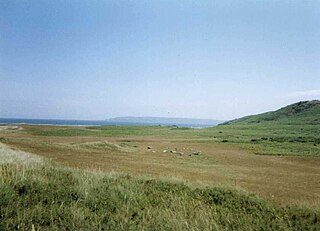
The Big/Great Roussel, Big Russel or Grand Ruau is the channel running between Herm on the west, and Brecqhou, and Sark on the east, in the Channel Islands. It has a treacherous current, and the tidal variations in this region are amongst some of the most extreme in the world. It hides a number of sunken rocks.
This is a list of coats of arms of the United Kingdom, its constituent parts, Crown Dependencies and its Overseas Territories.

The flag of Alderney was granted on 20 December 1993. The flag is composed of St George's Cross with Alderney's coat of arms in the centre, and a lion holding a sprig on a green background with a golden border.

The coat of arms of Guernsey is the official symbol of the Channel Island of Guernsey. It is very similar to the arms of Normandy, Jersey, and England.
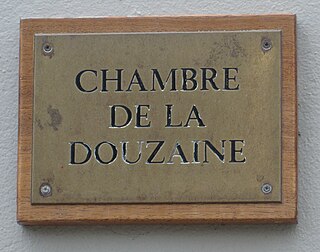
The Bailiwick of Guernsey includes the island of Guernsey and other islands such as Alderney, Sark, Herm, Jethou, Brecqhou, and Lihou. Each parish was established, probably in the 11th century, as a religious area, each having its parish church. Administratively each parish is now administered by an elected council known as a Douzaine.

The Trident Charter Company is a shipping firm based in Guernsey, Channel Islands. The company operates the ferry route between Guernsey and Herm using the Herm Trident V, a twin Iveco diesel-powered catamaran with a steel hull. The ferry sails daily from St Peter Port Harbour, and docks at either Herm Harbour or Rosaire Steps, depending on the state of the tide. The crossing takes between 15 and 20 minutes depending on sea-state and tide.

The following outline is provided as an overview of and topical guide to Guernsey:

The flag of Sark is white with a red St. George's cross and a red canton containing the two yellow lions from the flag of Normandy. The flag was formally granted as the Flag of Sark in 2020.
This gallery shows the coat of arms of each of the Dependent territories in the list of countries.

Guernsey Ambulance and Rescue Service is the ambulance and rescue service of Guernsey, the second largest of the Channel Islands, and also provides these services to other islands within the Bailiwick of Guernsey, both those directly governed, and those that are semi-autonomous dependencies of Guernsey. It is operated as a private company, but is a subsidiary of the Venerable Order of St John. Unlike ambulance services in the United Kingdom and Jersey, emergency ambulance and patient transport services are not free of charge. The service charges patients who do not have a paid annual subscription.

The first postal service took place using mail sent with captains of packet ships, using agents in the England and in the islands for the end delivery. The cost was normally 3d. The first pillar boxes in Britain were introduced in the Channel Islands as an experiment in 1852, to collect mail for the Royal Mail packet boats. The oldest pillar box in use in the British Isles is in Guernsey.

St Tugual's Chapel is a non-denominational and non-consecrated chapel which dates from the 11th century. It is located on Herm, the smallest of the Channel Islands open to the public. The Chapel is currently listed on the Register of Ancient Monuments and Protected Buildings for the States of Guernsey.
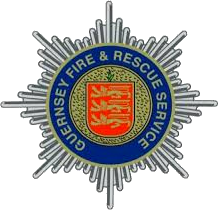
The Guernsey Fire and Rescue Service is the statutory fire and rescue service which deals with a broad range of incidents on Guernsey, including fires, road traffic accidents, assisting property owner after storm damage or flooding and incidents involving hazardous substances.


















